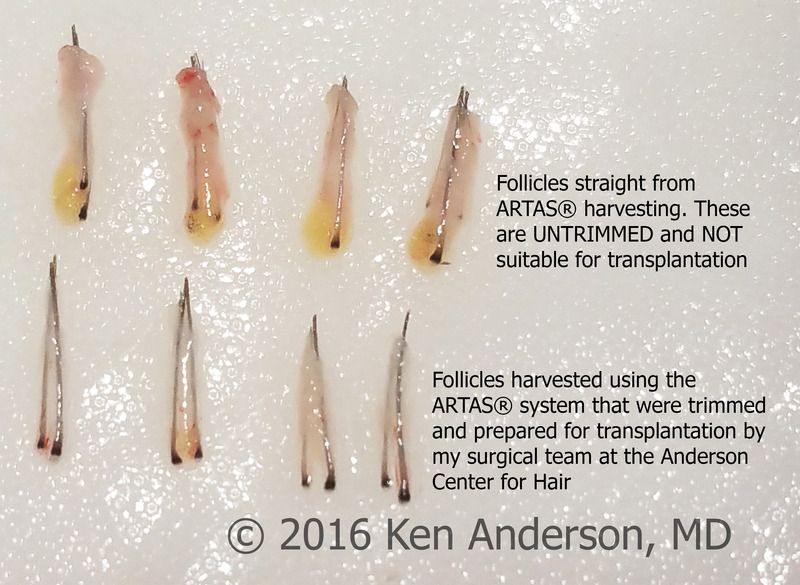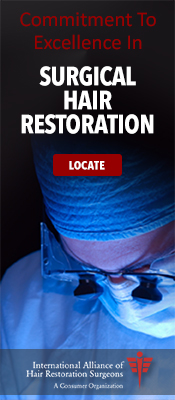-
Administrator

-
Member


these grafts were from an asian patient which notoriously have longer and thicker grafts. We used a 4 prongs (as per the images) with 6mm punch
-

I know I sound like an ARTAS cheerleader, but I swear I am not associated with the company. With that out of the way, I have to say again just how exciting this technology is. It's clear where this is going - a fully automated HT, done at a much faster pace with a much better outcome than anything that could be accomplished by a human. It eliminates all the guess work and variability that is unfortunately all too common in this industry.
I can just invasion a dozen of these lined up in an OR, all buzzing away on 12 people at a time. The economies of scale and speed will make HTs much more affordable, allowing many people who previously wouldn't have considered an HT to take the plunge. HTs will become just another medi-spa treatment, like so many other dermatological procedures.
-

 Originally Posted by Occulus

I know I sound like an ARTAS cheerleader, but I swear I am not associated with the company. With that out of the way, I have to say again just how exciting this technology is. It's clear where this is going - a fully automated HT, done at a much faster pace with a much better outcome than anything that could be accomplished by a human. It eliminates all the guess work and variability that is unfortunately all too common in this industry.
I can just invasion a dozen of these lined up in an OR, all buzzing away on 12 people at a time. The economies of scale and speed will make HTs much more affordable, allowing many people who previously wouldn't have considered an HT to take the plunge. HTs will become just another medi-spa treatment, like so many other dermatological procedures.
I’m fascinated by the technology as well, but like Spencer Kobren says, this is still surgery. No matter how advanced this technology gets I would not want to have surgery in a mass production line in a medispa. I also don’t believe this technology will bring down the cost. I think what is going to happen is that people will have to make a choice based on cost just like with with strip or FUE. Either go with the artas that is programed by a qualified physician, knowing that the surgery will be more consistent and standardized as it says in the post, or spend less and go with technicians. It seems that this is the direction hair transplants are going .
-
Member

-
IAHRS Recommended Hair Transplant Surgeon

 Trimmed vs. Untrimmed follicles - what is the difference? Trimmed vs. Untrimmed follicles - what is the difference?
Great looking grafts! The developments are nothing short of amazing. I wanted to share with readers what grafts look like straight from the ARTAS system, and what they look like after proper trimming. The ARTAS robot is not like a car wash where you just stick a patient in and *presto* out come the grafts and there you go. It's simply a tool. Like a paintbrush. No tool can guarantee good or even acceptable results, no more than any given paintbrush is going to result in the most beautiful paintings. It's the skill, talent, dedication and experience of the person using the tool. In this case it's an entire surgical team working in concert to provide the most optimal results for every single patient.
Pictured here are follicles freshly harvested using the ARTAS robot which are not suitable for transplantation, and below that follicles after proper trimming which are ready for transplantation. Quite a difference when you look really closely, for sure. For those not familiar with up-close views of untrimmed vs. trimmed follicles, one of the main differences is in the amount of dermal tissue (e.g.: skin) that is around the top of each follicle. Skin grafting works in the field of plastic surgery because skin wants to heal to other skin by nature. If this skin is left on the grafts it will heal into it's new location. The problem with transplanting skin along with follicles is that, just like in skin grafts, the tiny cuff of skin seen on the untrimmed grafts will heal into the recipient bed. This is a problem because if each hair brings a tiny bit of skin, and the skin doesn't happen to heal **perfectly** flush with the surrounding skin, the risk of 'cobblestoning' goes up significantly. Cobblestoning is the phenomenon where the surface of the skin that has received transplanted grafts no longer looks smooth but has bumps all over it, like an orange peel but much worse. It is something to avoid in a hair restoration procedure. So it's critical to have top-notch surgical staff with significant experience as their work under the microscope trimming these grafts is absolutely critical to an outstanding result.

Ken Anderson, MD, FISHRS, ABHRS
Founder, Director, and Chief of Surgery, Anderson Center for Hair
Assistant Clinical Professor of Surgery, David Geffen School of Medicine at UCLA
Board Certified, American Board of Hair Restoration Surgery
Board Certified, American Board of Facial Plastic and Reconstructive Surgery
Board Certified, American Board of Otolaryngology-Head and Neck Surgery
Member, International Alliance of Hair Restoration Surgeons
Fellow, International Society of Hair Restoration Surgery
Founder and President, American Academy of Hair Restoration Surgery
+1 (404) 256-4247
www.AtlantaHairSurgeon.com
View my IAHRS Profile

-
Member


this is a great write up!! were these grafts taken with a 19g needle?
-
IAHRS Recommended Hair Transplant Surgeon


Yes, they were taken with the 19g needle from a Caucasian patient, with an inter-harvest minimum distance of 1.690mm in the more dense areas, pulling back to 1.940mm or 2.000mm in the less dense areas over the ears. I think like a lot of people I assumed the density of hair was essentially constant all over the scalp. That was in 2002. Then I entered the field of hair restoration full time and discovered quickly that the density varies all over the scalp, sometimes significantly. Clearly over-harvesting and the resultant moth-eaten appearance is to be avoided, so paying attention to the density readout on the ARTAS User Interface is key to obtaining enough grafts without over-harvesting. I love that feature of the robot. After it orients to the tensioner, it shows me exactly how many follicles per cm squared are within the tensioner, and it allows me to make well-informed decisions about the density of harvesting, whereas prior it was basically just looking at the area and taking a guess based on what you saw. That was back in the days of hand-held FUE (2003-2013 for my center), and performing FUE surgery by hand just seems like the stone ages to me.
Ken Anderson, MD, FISHRS, ABHRS
Founder, Director, and Chief of Surgery, Anderson Center for Hair
Assistant Clinical Professor of Surgery, David Geffen School of Medicine at UCLA
Board Certified, American Board of Hair Restoration Surgery
Board Certified, American Board of Facial Plastic and Reconstructive Surgery
Board Certified, American Board of Otolaryngology-Head and Neck Surgery
Member, International Alliance of Hair Restoration Surgeons
Fellow, International Society of Hair Restoration Surgery
Founder and President, American Academy of Hair Restoration Surgery
+1 (404) 256-4247
www.AtlantaHairSurgeon.com
View my IAHRS Profile

-
Similar Threads
-
By tbtadmin in forum Hair Transplant Results By IAHRS Recommended Surgeons
Replies: 4
Last Post: 03-07-2016, 12:29 PM
-
By tbtadmin in forum Hair Transplant Results By IAHRS Recommended Surgeons
Replies: 0
Last Post: 01-07-2016, 01:22 PM
-
By rbernstein in forum Hair Transplant Results By IAHRS Recommended Surgeons
Replies: 0
Last Post: 03-11-2015, 10:07 AM
Tags for this Thread
 Posting Permissions
Posting Permissions
- You may not post new threads
- You may not post replies
- You may not post attachments
- You may not edit your posts
Forum Rules
|
» IAHRS

» The Bald Truth

» americanhairloss.org

|





 Reply With Quote
Reply With Quote












Bookmarks